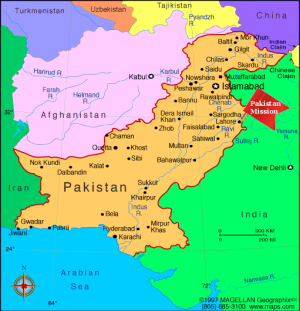
Other major cities: Karachi, located in the southeastern part of the country on the Arabian Sea, is the largest city, with a population of 13 million. The second-largest city is Lahore, with a population of 7 million.
Population: 187,342,000
Religions: 95% Muslim; 1.5% Christians, 1.5% Hindus, and 2% others
Languages: The official languages are Urdu and English. English is spoken predominantly by the upper classes. There are many regional and provincial languages; the most common is Punjabi, which is spoken by nearly 50% of the population.
Literacy: About 50% of the population is literate. Among males the literacy rate is 63% and among females 36%.
The modern state of Pakistan was created in 1947, when British India was divided into the predominantly Muslim country of Pakistan and the mostly Hindu country of India.
According to the World Bank, Pakistan’s gross national income, per capita, was $1,050 in 2010. (By comparison, it was $47,240 in the US.) The Orthodox in Pakistan are no exception; the vast majority struggles to make ends meet. A typical Orthodox family size is 6. On average, members of the Orthodox community complete 8 to 10 years of schooling. Fr. John frequently cites education as one of the greatest needs of the faithful; education will enable them to secure higher-paying work and better quality of life. Unfortunately young people drop out of school because they need to work to help support their families, and thus the cycle of poverty and lack of education continues.
Basic needs like shoes, school materials, and medicines are frequently unattainable for members of the Orthodox community.
As for religious tolerance, the government of Pakistan is officially tolerant of minority religions. Churches are given recognition and people of all faiths are permitted to worship. In recent years, however, Christians have increasingly come under attack—not by the government but by individuals.
